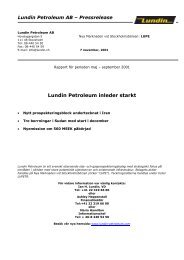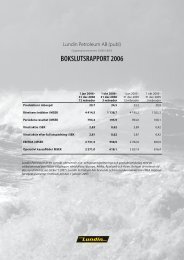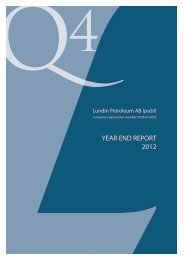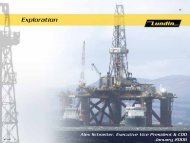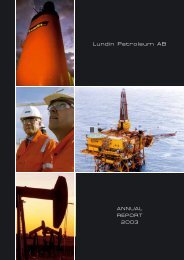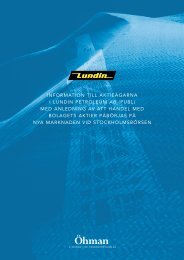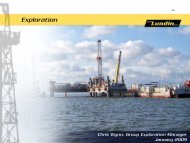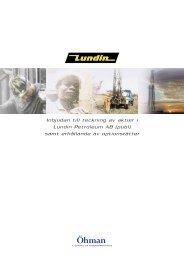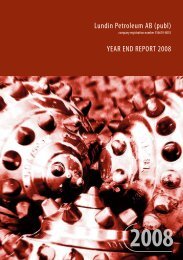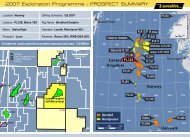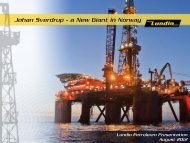Annual Report 2005 (6 MB) - Lundin Petroleum
Annual Report 2005 (6 MB) - Lundin Petroleum
Annual Report 2005 (6 MB) - Lundin Petroleum
Create successful ePaper yourself
Turn your PDF publications into a flip-book with our unique Google optimized e-Paper software.
ACCOUNTING PRINCIPLES<br />
ACCOUNTING PRINCIPLES ADOPTED BY THE GROUP<br />
Principles of consolidation<br />
Subsidiaries<br />
Subsidiaries are all entities over which the Group has the sole right<br />
to exercise control over the operations and govern the fi nancial<br />
policies generally accompanying a shareholding of more than half<br />
of the voting rights. The existence and eff ect of potential voting<br />
rights that are currently exercisable or convertible are considered<br />
when assessing the Group’s control. Subsidiaries are fully<br />
consolidated from the date on which control is transferred to the<br />
Group and are de-consolidated from the date that control ceases.<br />
The consolidated fi nancial statements of the <strong>Lundin</strong> <strong>Petroleum</strong><br />
Group have been prepared using the purchase method of<br />
accounting. The cost of an acquisition is measured as the fair<br />
value of the assets given, equity instruments issued and liabilities<br />
incurred or assumed at the date of exchange, plus costs directly<br />
attributable to the acquisition. Identifi able assets acquired<br />
and liabilities and contingent liabilities assumed in a business<br />
combination are measured initially at their fair values at the<br />
acquisition date, irrespective of the extent of any minority interest.<br />
The excess of the cost of acquisition over the fair value of the<br />
Group’s share of the identifi able net assets acquired is recorded as<br />
goodwill. If the cost of acquisition is less than the fair value of the<br />
net assets of the subsidiary acquired, the diff erence is recognised<br />
directly in the income statement.<br />
The minority interest in a subsidiary represents the portion of the<br />
subsidiary not owned by the Company. The equity of the subsidiary<br />
relating to the minority shareholders is shown as a separate item<br />
within equity for the Group.<br />
All intercompany profi ts, transactions and balances are eliminated<br />
on consolidation. Unrealised losses are also eliminated unless<br />
the transaction provides evidence of an impairment of the asset<br />
transferred. Accounting policies of subsidiaries have been changed<br />
where necessary to ensure consistency with the policies adopted<br />
by the Group.<br />
Associated companies<br />
An investment in an associated company is an investment in an<br />
undertaking where the Group exercises signifi cant infl uence but<br />
not control, generally accompanying a shareholding of at least<br />
20% but not more than 50% of the voting rights. Such investments<br />
are accounted for in the consolidated fi nancial statements in<br />
accordance with the equity method. The diff erence between<br />
the acquisition cost of shares in an associated company and the<br />
net fair value of the assets, liabilities and contingent liabilities of<br />
the associated company recognised at the date of acquisition<br />
is recognised as goodwill. The goodwill is included within the<br />
carrying amount of the investment and is assessed for impairment<br />
as part of the investment. The Group’s share in the post-acquisition<br />
results of the associated company is recognised in the income<br />
statement and the Group’s share in post-acquisition movements<br />
in the equity of the associated company are recognised the<br />
> 52 <<br />
Group’s equity. When the Group’s accumulated share of losses<br />
in an associated company equals or exceeds its interest in the<br />
associated company, the Group does not recognise further losses,<br />
unless it has incurred obligations or made payments on behalf of<br />
the associate.<br />
Other shares and participations<br />
Investments where the shareholding is less than 20% of the voting<br />
rights are treated as fi nancial instruments.<br />
Jointly controlled entities<br />
Oil and gas operations are conducted by the Group as co-licensees<br />
in unincorporated joint ventures with other companies. The<br />
Group’s fi nancial statements refl ect the relevant proportions of<br />
production, capital costs, operating costs and current assets and<br />
liabilities of the joint venture applicable to the Group’s interests.<br />
Foreign currencies<br />
Items included in the fi nancial statements of each of the Group’s<br />
entities are measured using the currency of the primary economic<br />
environment in which the entity operates (‘functional currency’).<br />
The consolidated fi nancial statements are presented in SEK, which<br />
is the currency the Group has elected to use as the presentation<br />
currency.<br />
Functional currency<br />
Monetary assets and liabilities denominated in foreign currencies<br />
are translated at the rates of exchange prevailing at the balance<br />
sheet date and recognised in the income statement. Transactions<br />
in foreign currencies are translated at exchange rates prevailing<br />
at the transaction date. Exchange diff erences are included in the<br />
income statement.<br />
Presentation currency<br />
The balance sheets and income statements of foreign subsidiary<br />
companies are translated for consolidation using the current rate<br />
method. All assets and liabilities of the subsidiary companies are<br />
translated at the balance sheet date rates of exchange, whereas<br />
the income statements are translated at weighted average rates of<br />
exchange for the year. The translation diff erences which arise are<br />
taken directly to the foreign currency translation reserve within<br />
shareholders’ equity. On a disposal of a foreign operation the<br />
translation diff erences relating to that operation will be transferred<br />
from equity to the income statement and included in the result<br />
on sale. Translation diff erences on long term intercompany loans,<br />
used for fi nancing exploration activities, are taken directly to<br />
shareholders’ equity.<br />
For the preparation of the annual fi nancial statements, the<br />
following currency exchange rates have been used.<br />
Average Period end<br />
1 Euro equals SEK 9.2800 9.3885<br />
1 USD equals SEK 7.4550 7.9584



